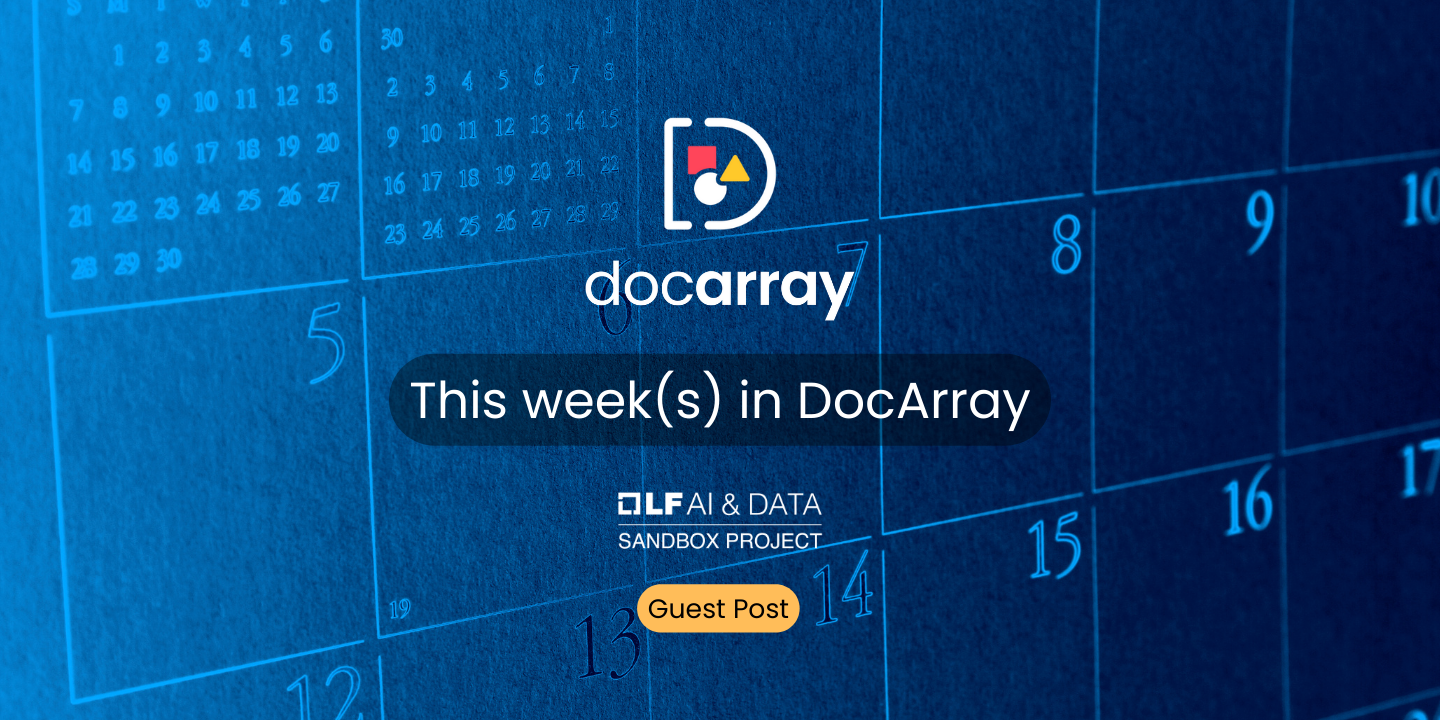It’s already been a month since the last alpha release of DocArray v2. Since then a lot has happened: we’ve merged features that we’re really proud of and keep crying tears of joy and misery trying to coerce Python into doing what we want. If you want to learn about interesting Python edge cases or follow the advancement of DocArray v2 development then you’re at the right place in this dev blog!
For those who don’t know, DocArray is a library for representing, sending, and storing multi-modal data , with a focus on applications in ML and Neural Search. The project just moved to the Linux foundation AI and Data and to celebrate its first birthday we decided to rewrite it from scratch, mainly because of a design shift and a will to solidify the codebase from the ground up.
MultiModalDataset
As part of our goal to make DocArray the go-to library for representing, sending, and storing multi-modal data, we‘ve added a
MultiModalDataset
class to easily convert DocumentArrays into PyTorch Dataset compliant datasets that can be used in the PyTorch DataLoader.
All you need is a DocumentArray and a dictionary of preprocessing functions and you’re up and running!
from docarray import BaseDocument, DocumentArray
from docarray.data import MultiModalDataset
from docarray.documents import Text
from torch.utils.data import DataLoader
class Thesis(BaseDocument):
title: Text
class Student(BaseDocument):
thesis: Thesis
da: DocumentArray[Student] = get_students()
ds: MultiModalDataset[Student] = MultiModalDataset[Student](
preprocessing={'thesis.title': embed_title, 'thesis': normalize_embedding},
loader: DataLoader = DataLoader(
ds, batch_size=4, collate_fn=MultiModalDataset[Student].collate_fn
# Use your loader just like any other dataloader for awesome DL training
If you’re interested in using DocArray for training, check out our example notebook , or take a peek at implementation details of MultiModalDataset .
TensorFlow support
After recently adding PyTorch support, we’ve now gone on to add TensorFlow support to DocArray v2. Like with PyTorch, we planned on subclassing the
tensorflow.Tensor
class with our
TensorFlowTensor
class. By doing so we want to allow DocArray to run operations on it while also being able to hand over our
TensorFlowTensor
instance to ML models or TensorFlow functions without TensorFlow being confused about this instance’s class but instead recognizing it as its own. Since we implemented this for PyTorch already, this should be easy, right?
But stop, not so fast. At first glance, TensorFlow tensors seem to be of class
tf.Tensor
, right?
import tensorflow as tf
tensor = tf.zeros((5,))
tensor
<tf.Tensor: shape=(5,), dtype=float32, numpy=array([0., 0., 0., 0., 0.], dtype=float32)>
When trying to subclass
tf.Tensor
though, we notice that this does not seem to work:
from typing import Any, Type, Union, cast
import tensorflow as tf
from docarray.typing.tensor.abstract_tensor import AbstractTensor
from pydantic.tools import
parse_obj_as
class TensorFlowTensor(AbstractTensor, tf.Tensor):
@classmethod
def validate(cls, value, field, config) -> 'TensorFlowTensor':
if isinstance(value, tf.Tensor):
value.__class__ = cls
return cast(TensorFlowTensor, value)
else:
raise ValueError(f'Expected a tf.Tensor, got {type(value)}')
our_tensor = parse_obj_as(TensorFlowTensor, tf.zeros((5,))) # will fail
Parsing a
tf.Tensor
as
TensorFlowTensor
will fail:
pydantic.error_wrappers.ValidationError: 1 validation error for ParsingModel[TensorFlowTensor]
__root__
__class__ assignment: 'TensorFlowTensor' object layout differs from 'tensorflow.python.framework.ops.EagerTensor' (type=type_error)
But wait, here they talk about an
EagerTensor
, not
tf.Tensor
. This is because TensorFlow actually supports eager execution and as well as graph execution. It defaults to eager execution, where operations are evaluated immediately. In graph execution, a computational graph is constructed for later evaluation.
So maybe we just need to extend TensorFlow’s
EagerTensor
then!
This, however, doesn’t work either, because the class
EagerTensor
is created on the fly, which is why trying to extend this class will fail with:
TypeError: type 'tensorflow.python.framework.ops.EagerTensor' is not an acceptable base type
.
With all that being said, we’ve decided to go with the following solution for now:
Instead of extending TensorFlow’s tensor, we store a
tf.Tensor
instance as an attribute of our
TensorFlowTensor
class. Therefore if you want to perform operations on the tensor data or hand it over to your ML model, you have to explicitly access the
.tensor
attribute:
import tensorflow as tf
from docarray.typing import TensorFlowTensor
t = TensorFlowTensor(tensor=tf.zeros((224, 224)))
# tensorflow functions
broadcasted = tf.broadcast_to(t.tensor, (3, 224, 224))
broadcasted = tf.broadcast_to(t.unwrap(), (3, 224, 224))
broadcasted = tf.broadcast_to(t, (3, 224, 224)) # this will fail
In future we plan to take a closer look and find a solution that enables handling
TensorFlowTensor
s just like our
TorchTensor
s. In particular, we plan to investigate if there’s an equivalent in TensorFlow to Torch’s
__torch_function__()
, which we told you about in the
previous blog post
. With such an equivalent and some tricks here and there we hope to enable smooth usage or our
TensorFlowTensor
class and make it feel like it’s a subclass of TensorFlow’s tensor, without it actually being one.
Nested class and multiprocessing
As part of our goal to make DocArray the go-to library for representing, sending, and storing multi-modal data, it’s important that DocumentArrays support multiprocessing, namely processing on multi-CPU cores.
In particular, we recently implemented a
MultiModalDataset
class to easily convert a DocumentArray into a dataset that can be used in the PyTorch DataLoader. The PyTorch DataLoader wraps the Python multiprocessing module to implement preprocessing with multiple CPUs.
The problem
One of the well-known issues with multiprocessing is that it doesn’t support classes that are declared inside a function:
def get_class():
class B:
return B
MyClass = get_class()
def foo(*args):
return MyClass()
import multiprocessing as mp
with mp.get_context('fork').Pool(2) as p:
print(p.map(foo, range(2)))
Traceback (most recent call last):
File "/Users/jackmin/Jina/docarray/meow.py", line 13, in <module>
print(p.map(foo, range(2)))
File "/Users/jackmin/miniconda3/envs/docarray/lib/python3.10/multiprocessing/pool.py", line 367, in map
return self._map_async(func, iterable, mapstar, chunksize).get()
File "/Users/jackmin/miniconda3/envs/docarray/lib/python3.10/multiprocessing/pool.py", line 774, in get
raise self._value
multiprocessing.pool.MaybeEncodingError: Error sending result: '[<__main__.get_class.<locals>.B object at 0x10152e950>]'. Reason: 'AttributeError("Can't pickle local object 'get_class.<locals>.B'")'
Pickling
This is because multiprocessing uses pickle to share objects with workers. Pickling only saves the qualified class name of an object and unpickling requires re-importing the class by its qualified class name. For that to work, the class needs a global qualified name. Classes defined by functions are local and thus cannot be pickled:
def get_class():
class B:
return B
MyClass = get_class()
import pickle
pickle.dump(MyClass(), open('meow.pkl', 'wb'))
Traceback (most recent call last):
File "/Users/jackmin/Jina/docarray/meow.py", line 10, in <module>
pickle.dump(MyClass(), open("meow.pkl", "wb"))
AttributeError: Can't pickle local object 'get_class.<locals>.B'
In order to get around this, we need to make the declared class global:
def get_class():
global B
class B:
return B
MyClass = get_class()
import pickle
pickle.dump(MyClass(), open('meow.pkl', 'wb'))
We can now load the pickles in a separate process as long as the process has a declaration of our class:
def get_class():
global B
class B:
return B
MyClass = get_class()
import pickle
print(pickle.load(open('meow.pkl', 'rb')))
It doesn’t really matter how it ends up in the global scope. We can even do this:
class B:
import pickle
print(pickle.load(open('meow.pkl', 'rb')))
The fix?
Ok. It just wants it to be global. Simple enough right? Let’s just plop
global
in front of our declaration and be done with it.
def get_class():
global B
class B:
return B
MyClass = get_class()
def foo(*args):
return MyClass()
import multiprocessing as mp
with mp.get_context('fork').Pool(2) as p:
print(p.map(foo, range(2)))
Yay this runs fine. But, what if our function returns a different class depending on the input arguments? I mean, why else would I want to return a class from a function?
def get_class(version: int):
global B
class B:
VERSION: int = version
return B
C1 = get_class(1)
C2 = get_class(2)
def get_version(cls):
print(cls)
return cls.VERSION
import multiprocessing as mp
with mp.get_context('fork').Pool(2) as p:
print(p.map(get_version, [C1, C2]))
<class '__main__.B'>
Traceback (most recent call last):
File "/Users/jackmin/Jina/docarray/meow.py", line 19, in <module>
print(p.map(get_version, [C1, C2]))
File "/Users/jackmin/miniconda3/envs/docarray/lib/python3.10/multiprocessing/pool.py", line 367, in map
return self._map_async(func, iterable, mapstar, chunksize).get()
File "/Users/jackmin/miniconda3/envs/docarray/lib/python3.10/multiprocessing/pool.py", line 774, in get
raise self._value
File "/Users/jackmin/miniconda3/envs/docarray/lib/python3.10/multiprocessing/pool.py", line 540, in _handle_tasks
put(task)
File "/Users/jackmin/miniconda3/envs/docarray/lib/python3.10/multiprocessing/connection.py", line 211, in send
self._send_bytes(_ForkingPickler.dumps(obj))
File "/Users/jackmin/miniconda3/envs/docarray/lib/python3.10/multiprocessing/reduction.py", line 51, in dumps
cls(buf, protocol).dump(obj)
_pickle.PicklingError: Can't pickle <class '__main__.B'>: it's not the same object as __main__.B
Can't pickle <class '__main__.B'>: it's not the same object as __main__.B
. What does that mean?
Double declaration
Well, our little trick has some caveats. By performing a global declaration, we’re essentially taking the class declaration out into the top-level scope. This means we’re essentially doing this:
class B:
VERSION: int = 1
C1 = B
class B:
VERSION: int = 2
C2 = B
def get_version(cls):
print(cls)
return cls.VERSION
import multiprocessing as mp
with mp.get_context('fork').Pool(2) as p:
print(p.map(get_version, [C1, C2]))
If we run this code, we get the exact same error we got before:
<class '__main__.B'>
Traceback (most recent call last):
File "/Users/jackmin/Jina/docarray/wow.py", line 15, in <module>
print(p.map(get_version, [C1, C2]))
File "/Users/jackmin/miniconda3/envs/docarray/lib/python3.10/multiprocessing/pool.py", line 367, in map
return self._map_async(func, iterable, mapstar, chunksize).get()
File "/Users/jackmin/miniconda3/envs/docarray/lib/python3.10/multiprocessing/pool.py", line 774, in get
raise self._value
File "/Users/jackmin/miniconda3/envs/docarray/lib/python3.10/multiprocessing/pool.py", line 540, in _handle_tasks
put(task)
File "/Users/jackmin/miniconda3/envs/docarray/lib/python3.10/multiprocessing/connection.py", line 211, in send
self._send_bytes(_ForkingPickler.dumps(obj))
File "/Users/jackmin/miniconda3/envs/docarray/lib/python3.10/multiprocessing/reduction.py", line 51, in dumps
cls(buf, protocol).dump(obj)
_pickle.PicklingError: Can't pickle <class '__main__.B'>: it's not the same object as __main__.B
What happened here? By declaring the class twice, we’ve overwritten our first
Class B
with a second
Class B
in the global scope. Pickle is aware of this when it tries to serialize
C1
. It will notice that the
Class B
C1
refers to is no longer the top-level one and raises an exception.
Qualified names must be unique
The issue here is that both
Class B
s have the same qualified name. Thus, both definitions are fighting over who gets to be the one the global dictionary knows about.
We can resolve this conflict and allow our two classes to live together peacefully by moving them to different qualified names and thus, different keys in the global scope:
def get_class(version: int):
global B
class B:
VERSION: int = version
B.__qualname__ = B.__qualname__ + str(version)
globals()[f'B{version}'] = B
return B
C1 = get_class(1)
C2 = get_class(2)
def get_version(cls):
print('Class Name:', cls.__name__)
print('Class Qualified Name:', cls.__qualname__)
print('Type repr', cls)
return cls.VERSION
import multiprocessing as mp
with mp.get_context('fork').Pool(2) as p:
print(p.map(get_version, [C1, C2]))
Class Name: B
Class Qualified Name: B1




